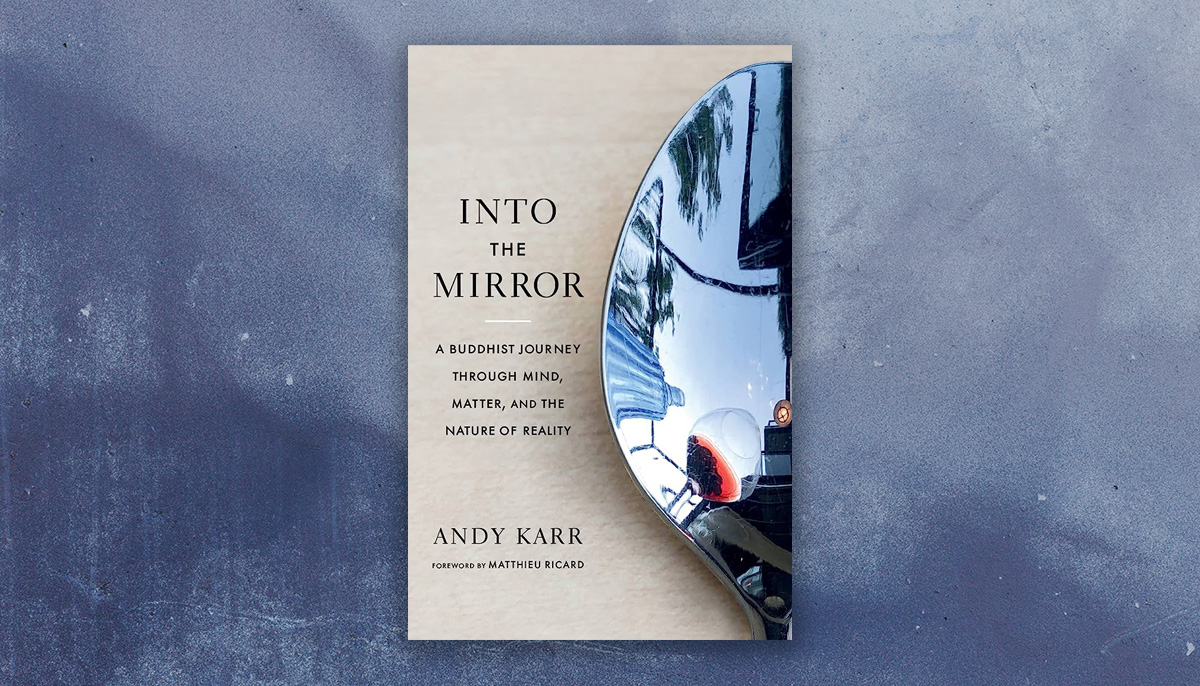This excerpt of chapter 16 of Andy Karr’s new book, Into the Mirror: A Buddhist Journey Through Mind, Matter, and the Nature of Reality — reviewed in the Summer 2023 issue of Buddhadharma: The Practitioner’s Guide — is provided courtesy of the publisher, Shambhala Publications. We thank Shambhala for sharing this with Buddhadharma‘s readers, and we thank our readers for supporting dharma publishers.
Two Realities
Since all things can be seen genuinely or falsely,
Every thing bears two natures.
The Buddha taught that the object of genuine seeing is suchness
And that false seeing is the relative truth.
—Chandrakirti
I have a calligraphy in my living room that was painted by my teacher Chögyam Trungpa Rinpoche. It’s a Tibetan trans literation of the Sanskrit word mudra, which means “symbol” or “gesture.” The calligraphy was a gift from Rinpoche that was sent to me when I was living in Paris with my family in the 1980s.
Strictly speaking, none of this is true. The calligraphy that I now see has no relationship to the one I remember receiving. It is empty of all my fabrications about what it is: its past, its present, or its future. Ultimately, the nature of this fresh moment of experience is emptiness. Conventionally—the way we normally think about things—the story of the calligraphy is accurate.
We experience two realities: the reality of dependently arisen appearances and the reality of our thoughts. To the deluded mind, these seem to all be one reality. When I look at the calligraphy, it seems to really be the word mudra, to be a gift from Trungpa Rinpoche. I don’t distinguish what I see from my conceptions about it. These fabrications seem to exist objectively, right within the object. In fact, they only exist subjectively, within the mind of the subject.
If someone else walks into the room, someone who can’t read Tibetan, who doesn’t know who painted the calligraphy or how it came to be there, they would have a completely different experience. They would experience similar visual appearances but completely different thoughts about what they were viewing.
These two ways of experiencing are called samvriti satya and paramartha satya in Sanskrit, terms that are often translated into English as relative truth and ultimate truth.
Satya means “reality or truth.” Samvriti means “conventional or relative,” but it also has the connotation of concealing, obscuring, or deceiving. Samvriti satya is conventional reality—truth, or reality, that conceals. Normally, we think of truth as something that reveals, but samvriti satya is truth that both reveals and conceals. What it reveals is our understanding of what things are, why things happen, how things fit into the world. What it con ceals is the nature of our experience.
Paramartha means “highest, supreme, or absolute.” Absolute reality is what is directly perceived by prajnaparamita or wisdom. Followers of the Middle Way describe this reality as shunyata (emptiness). It is not nothingness but rather the dynamic display of emptiness: dependently arisen sights, sounds, tastes, smells, tactile sensations, and mental phenomena that appear, while having no nature of their own.
To get a feel for these two realities, think of someone you know. When you do this, they will seem to exist in certain ways: having a certain temperament, a certain history, certain ways of behaving. You will also have attitudes toward this person. When you talk with your friends, they might have similar feelings and narratives. You might also know people with very different concepts about that person. That person will have still another very different picture of themselves. All these versions of the person are merely conventionally real. They seem to be what the person actually is, but ultimately, the person is free from all these fabrications—even their own. The nature of that person is emptiness. Relative reality conceals what is ultimately real.
The Conventional
Conventional reality only appears to the conceptual mind. It does not appear to the senses. The brilliant twentieth-century Tibetan scholar Gendun Chöpel explained it in this way:
All of our decisions about what is and is not are just decisions made in accordance with how it appears to our mind; they have no other basis whatsoever. Therefore, when we ask, “Does it exist or not?” and the other person answers, “It exists,” in fact, we are asking, “Does this appear to your mind to exist or not exist?” and the answer is simply, “It appears to my mind to exist.” In the same way, everything that one asks about—better or worse, good or bad, beautiful or ugly—is in fact merely asked about for the sake of understanding how the other person thinks. That the other person makes a decision and answers is in fact just a decision made in accordance with how it appears to his or her own mind; there is no other reason whatsoever. Therefore, as long as the ideas of two people are in disagreement with each other, they will argue. When they agree, the very thing that they agree upon will be placed in the class of what is, what exists, what can be known, and what is valid, and so on. Thus, the more people there are who agree, the more the point they agree upon becomes of great significance and importance. Contrary views are taken to be wrong views, mistaken perceptions, and so on. . .
And:
But is it not appropriate to place one’s confidence in that very decision which has been made by one’s own mind? It is not the case. Sometimes this mind of ours seems mistaken, sometimes it seems correct. It is established by experience that it is always deceptive, like the divination of a bad soothsayer. Who can trust it? Many things that are decided to be in the morning are decided not to be in the evening. Things that are decided to be early in life are decided not to be later in life. Things that one hundred thousand Muslims decide are true are decided to be false by one hundred thousand Buddhists.
You may well resist this way of understanding reality. After all, we learn from an early age that the world exists independently of our thoughts. There are facts about this world and statements about these facts that are either true or false. It’s natural to think that relative truth must be grounded in the way things really are.
But if these truths are not part of the fabric of reality, what are they?
Conventional reality is based on the common consensus of humans. Take money, for example. Those pieces of paper that we call currency, the balances in our bank accounts, the payments we send and receive, all seem meaningful and very, very real. We can exchange them for tangible goods and services of all kinds. Money can even be a matter of life or death. Yet, there is nothing in those dollars, euros, and pesos that gives them any reality other than our shared conceptions of their value. This is not difficult to understand. We see this quite vividly when people lose faith in a currency because of hyper-inflation causing the value to disappear.
Measurements of time are also conventional reality. The days of the week, the hours of the day, the months of the year—all these are merely conceptions. They work as long as we all agree to them. They are just fabrications, but they are useful fabrications. If you agree to meet your friends at 2:00 p.m. on Tuesday, you and your friends can bring about the causes and conditions for that meeting to take place.
The shapes of the letters on this page, the sounds they signify, the meanings of these words—all these are merely conventions that have been drilled into you so thoroughly that when you look at these shapes, the sounds and meanings actually seem to exist on the page. But the sounds and meanings have no existence beyond your own mind.
Some conventional realities are merely dependently imputed. Fast depends on slow. Large depends on small. Beautiful depends on ugly. None of these exist apart from the conceptions.
Some conventional truths are derived from observing patterns of dependent arising. Farmers see that the appearance of strong, healthy plants depends on gathering certain conditions of soil, seeds, water, and weather. Concepts about these dependencies are shared with other farmers, and they become the common consensus about farming.
Scientific Realities
The realities established by science and technology might seem to be of an entirely different order. They might seem ultimately true; proven by the amazing things that these methods are able to predict and produce. However, even these realities are merely conventional. The scientific method consists of clearly articulated procedures for observation and theory formation that produce rigorous conceptual models of reality, but these models are not genuine reality itself. They are mental constructions: abstractions of reality.
In his Herbert Spencer Lecture, delivered at Oxford in 1933, Albert Einstein described the relationship between scientific theory and direct experience:
I want now to glance for a moment at the development of the theoretical method, and while doing so especially to observe the relation of pure theory to the totality of the data of experience. Here is the eternal antithesis of the two inseparable constituents of human knowledge, Experience and Reason, within the sphere of physics. We honour ancient Greece as the cradle of western science. She for the first time created the intellectual miracle of a logical system, the assertions of which followed one from another with such rigor that not one of the demonstrated propositions admitted of the slightest doubt—Euclid’s geometry. . . . But yet the time was not ripe for a science that could comprehend reality, was not ripe until a second elementary truth had been realized, which only became the common property of philosophers after Kepler and Galileo. Pure logical thinking can give us no knowledge whatsoever of the world of experience; all knowledge about reality begins with experience and terminates in it.
Conclusions obtained by purely rational processes are, so far as Reality is concerned, entirely empty.
The great Danish physicist Niels Bohr wrote this about the relationship of physics to experience: “Physics is to be regarded not so much as the study of something a priori given, but as the development of methods for ordering and surveying human experience.”
Science functions. It is useful. It can reveal profound and subtle things about the dependent appearances of this world. Science also conceals. When we think about the world in physical, chemical, or biological terms, whether at the elementary school level or the postdoctoral level, that thinking conceals the dynamic display of empty appearance. We don’t recognize the nature of the conceptuality that appears to our minds. We take the abstractions to be real stuff, and these beliefs confirm our impressions that the world consists of solid, lasting, independently existing things, and that we are also solid, lasting, independently existing things. We are bound by these conceptions, and all the conditioning that arises from them, and thus fail to realize the peace that lies beyond conceptions.
From Into the Mirror: A Buddhist Journey through Mind, Matter, and the Nature of Reality by Andy Karr © 2023 by Andy Karr. Reprinted in arrangement with Shambhala Publications, Inc. Boulder, CO. www.shambhala.com
For more on the latest dharma books, read this issue’s edition of Buddhadharma on Books. Or see more excerpts and other digital exclusives for Buddhadharma readers here.

